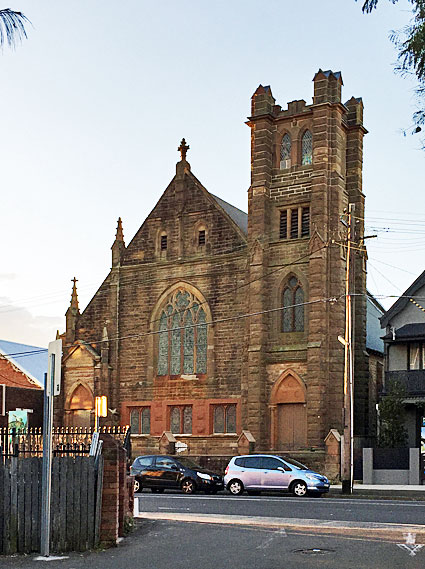
Grahame Memorial Uniting (formerly Presbyterian) Church, Waverley
[Photograph by Kurt Ison (May 2015)]

Grahame Memorial Uniting (formerly Presbyterian) Church, Waverley
[Photograph by Kurt Ison (May 2015)]
Historical and Technical Documentation by Graeme Rushworth and others
© OHTA 1988, 2016 (last updated April 2016)1
The foundation stone of this stone church was laid by Mrs. William Grahame on 8 May 1897, and the building was opened on 5 February 1898.2 It replaced the first church, opened on 17 January 1885, which was retained as a hall.3 The latter has since suffered, in heritage terms, from alterations and additions.4
Built in neo-Gothic style, the 1898 church was designed by the Sydney architects Messrs Nixon and Allen,5 and is now leased by the Uniting Church as the Jubilee International Church.
First Organ.
A small organ was purchased before 1893, the year in which the surviving church records commence.
The organ was probably purchased secondhand: its appearance suggests it was of c.1880. It displayed defects in voicing, tuning and action, and was affected by dampness. It was largely maintained by a Mr Bracewell, but both W.G. Rendall and C. Richardson were asked to inspect and report on its condition. It was moved into the present church when it opened.
In 1902 it was decided to replace the organ. A letter was received in June 1904 from St Mark's Anglican Church, Granville, offering £65 for the old organ and this was accepted.
The instrument was moved to St Mark's Church where it served until 1955. At this time it was broken up by J.P. Eagles, and the pipework was used in a new instrument with electric action. This lasted scarcely 20 years and was sold in 1974.
Before it was broken up, photographs show the instrument to have been of two manuals and pedals, and probably eight or nine stops plus three couplers. The case posts had elaborate cornices and pinnacles, and above the inbuilt console were doors, like those of a Brustwerk. The pedal board was parallel and flat. Display pipes were arranged in two towers to either side of a central flat above the opening doors. The central pipes may have been dummies, as no feet are visible.6
Second Organ.
The second organ in this church was opened on 31 May 1904 by Mr Arthur Mason, the City Organist:
NEW ORGAN OPENING
On Tuesday evening the new organ in the Grahame Memorial Presbyterian Church, Waverley, will be opened by the city organist, Mr. A. Mason, who will be assisted by Master Reginald Massey, Mr. Henry Weir, and Mr. O. Rosenthal.7
There had been some criticism by George Fincham of the scheme initially proposed by the church, but a specification comprising 2 manuals, 12 stops, 3 couplers and tremulant was finally accepted on 14 December 1903. Fincham advised that work on the organ had commenced by 17 December.8 Fincham initially advised the church in May 1904 to place the care of the instrument in the hands of William Davidson, who had "special knowledge of modern tubular-pneumatic action," but informed them in December that year that he was in a position to take care of the organ himself.9 The organ was located at the front of the church.
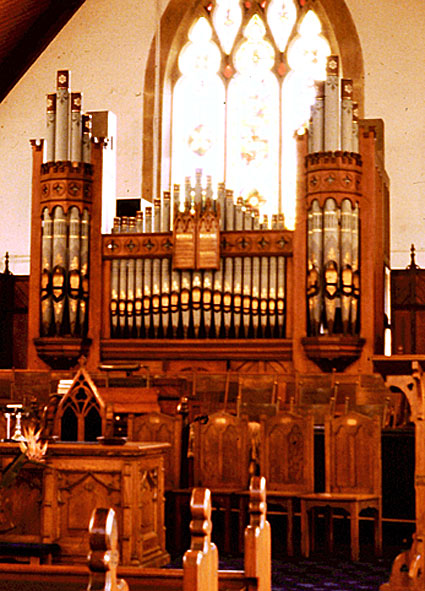
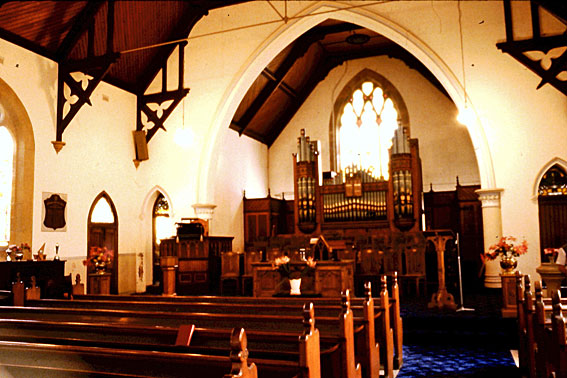
The George Fincham & Son organ of 1904
[Photographs by Kelvin Hastie (March 1983)]
Documentation by John Stiller notes that two stops (Swell Cornopean 8' and Pedal Open Diapason 16') were later additions, and that there were stamped inscriptions on the Cornopean, whereas the original pipework had hand inscriptions.10 Simon Pierce confirms that the original swell box had been enlarged at some stage and that the swell windchest (now at St Peter's Anglican Church, Southport, Qld) includes a clamp.11 As C.W. Leggo had Fincham's agency in Sydney early in the 20th century, Kelvin Hastie has suggested that the additions were probably made by Leggo, using Palmer pipework for the reed, as he did elsewhere.12 By the time the specification below was noted, therefore, the instrument comprised 14 stops.
A detached roll-top console with drawstops had key cheeks of the distinctive profile frequently used by the firm at this period. The case comprised two bayed towers and a central flat of display pipes arranged 15-19-5, beautifully decorated in sky blue with bands of terracotta and black, with dark blue and gold detail. A builder's plate of ivory was affixed to the console behind the music desk.13
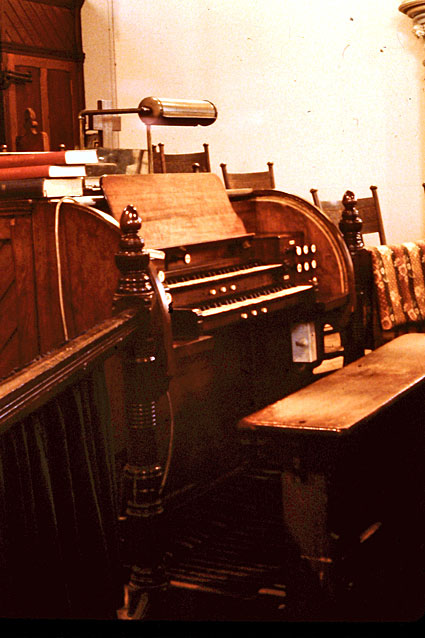
Detached roll-top console
[Photograph by Kelvin Hastie (March 1983)]
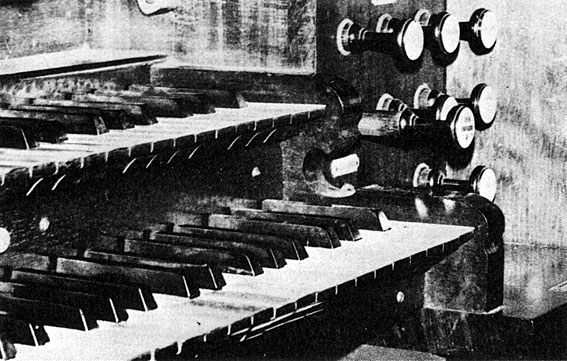
Console detail, showing the distinctive key cheek profile
[Photograph by G.D. Rushworth (c.1981)]
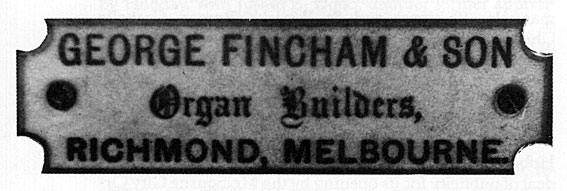
The builder's plate, 1904
[Photograph by G.D. Rushworth (c.1981)]
The stop list was as follows:
GREAT |
|
[later addition, undated] [later addition, undated] |
compass: 56/30
parallel concave pedalboard
lever swell lever
3 composition pistons to great
3 composition pedals to swell
tubular-pneumatic action.14
The organ was removed from the Waverley church in the 1990s, and has since been dispersed. Most of the Swell, including the soundboard, was incorporated by W.J. Simon Pierce of Brisbane in 2014 into the enlarged organ at St Peter's Anglican Church, Southport, Qld. Four stops from the Great (Open Diapason 8ft, Dulciana 8ft, Principal 4ft and Flute 4ft) were included in 2016 in the rebuilt and enlarged organ at St Paul's Anglican Church, Ipswich, Qld, while the Great Claribel 8ft found its way in 2007 to Holy Trinity Anglican Church, Mackay.
____________________________________________________________________
1 All of the information presented here concerning the first organ, and some of that concerning the second organ was published originally in Graeme D. Rushworth, Historic Pipe Organs of New South Wales (Sydney: Hale & Iremonger, 1988), pp. 184, 424. Further information supplied by Geoffrey Cox and Kelvin Hastie.
2 The Sydney Morning Herald (10 May 1897), p. 3; The Sydney Morning Herald (7 February 1898), p. 7.
3 Grahame Memorial Presbyterian Church, Trustees Minutes 1892-98, cited by Graeme Rushworth.
4 Heritage Listing at www.environment.nsw.gov.au › Heritage sites › Searches and directories (Database number: 2620286), accessed April 2015.
5 The Sydney Mail and New South Wales Advertiser (29 May 1897), p. 1139; The Sydney Morning Herald (14 September 1935), p. 9.
6 Grahame Memorial Presbyterian Church, Trustees Minutes 1892-98 and Committee of Management Minutes 1893-1904, cited by Graeme Rushworth; Personal communication from N. Hubbard to Graeme Rushworth, July 1980.
7 The Sydney Morning Herald (30 May 1904), p. 10.
8 George Fincham Letter Book, vol.19, p. 574 (14 Oct. 1903), vol. 16, p. 341 (14 Dec. 1903), vol. 19, p. 694 (17 Dec. 1903) – cited by Geoffrey Cox in Fincham/Matthews Collection (State Library of Victoria, MS 9423). See also: E.N. Matthews, Colonial Organs and Organbuilders (Carlton: Melbourne University Press, 1969), pp. 191, 269.
9 George Fincham Letter Book, vol. 19, p. 962 (18 May 1904), vol. 20, p. 331 (15 Dec. 1904) – cited by Geoffrey Cox in Fincham/Matthews Collection (State Library of Victoria, MS 9423).
10 John Stiller, Grahame Memorial Uniting Church, Waverley, NSW: Standard Documentation of Pipe Organ built by Geo. Fincham & Son 1904 (Camberwell: OHTA, 1985), cited by Kelvin Hastie, April 2015.
11 Personal communication to Geoffrey Cox from Simon Pierce, 18 May 2015.
12 Personal communication to Geoffrey Cox from Kelvin Hastie, 26 April 2015.
13 Rushworth, p. 184.
14 Specification given in Stiller Documentation, op. cit., and noted at Waverley by Graeme Rushworth, April 1981.